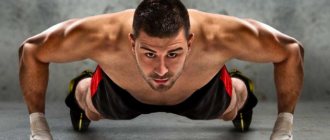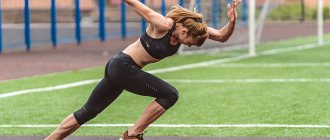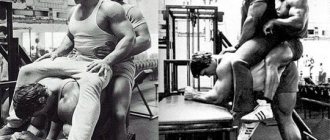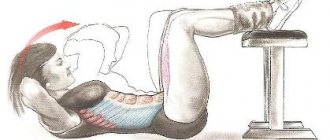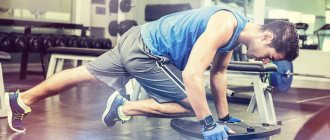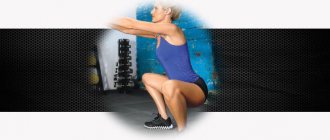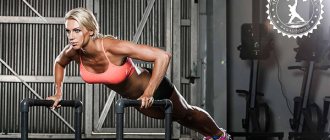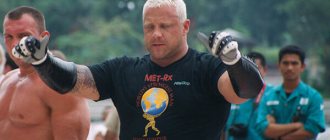Today there are a large number of sports clubs and gyms, but push-ups will still be considered only the main and effective exercise. You can perform this exercise at any time, under any conditions, in various ways. This is exactly the point of view of the people who set records in this discipline.
Small and smart
The youngest Russian athlete from Voronezh was only twelve years old when she set a record for push-ups on one finger. Yulia Alyokhina simply masterfully rested on her thumb and did push-ups without touching her feet to the floor. True, the world also knows younger athletes. Ronak Atul Vitha from India is the youngest record holder. Born in 2005, he began doing push-ups at the age of 2.5 years. He is currently a master of sports in push-ups, and his record is 1482 push-ups in 40 minutes.
World records
The Guinness World Records for push-ups include the following categories:
- First record holder. The greatest number of push-ups in one set, first recorded in the Guinness Book of Records, belongs to Charles Linster. In the middle of the 20th century, he performed this exercise 6006 times;
- Do not stop. The longest running series belongs to Minoru Yoshida. A resident of Japan first set his world record, recorded in the Guinness Book of non-stop push-ups, and it was 10,507 times. To date, no one has been able to beat this achievement;
- Daily limit. The highest number of push-ups belongs to Charles Servinzio, who did this exercise 46,001 times in 21 hours;
- Leaning on 1 limb. Ivan de Weber did one-arm push-ups 120 times in 60 seconds. At the beginning of 2010, Giorgi Basilashvili did 157 push-ups during the same time period. The Georgian boy was only 16 years old when he set his world record;
- Leaning on the bars. Simon Kent was able to do 140 push-ups in 60 seconds. Four years earlier, he performed the parallel bars exercise 3,989 times in 60 minutes;
- Leaning on your fingers. A resident of Chechnya, Zhabrail Azizaev, did a record 67 push-ups in 30 seconds.
Do push-ups to live!
And in the end I would like to give you probably the most motivating example for training in push-ups. Anita Sycheva, a resident of Zaporozhye, once got into a serious car accident, after which she was bedridden for two years. And what helped the middle-aged woman in such a difficult life situation? Sport! She now does 1,000 push-ups without rest.
As you can see, the possibilities for setting personal records in push-ups are endless! And our records depend solely on our willpower and training process. Nowadays, for more convenient training, there is a push-up counter intended for personal use and passing standards. It can be purchased in the section “Equipment for passing standards”
Types of push-ups
While there are many types of push-ups, there is a common, basic technique:
- The starting position is face down on a flat floor, resting your palms on it.
- Place your hands shoulder-width apart, spread your legs slightly to the sides, and place your toes on the floor.
- As you inhale, lower your body, bending your elbows (until you achieve a 90° angle).
- As you exhale, you come back.
A slow pace of execution is allowed for beginners who are not yet able to energetically control their body.
When done regularly, the pace increases, and you already know how many push-ups you need to do and at what optimal rhythm. Important! The body line should be kept straight. There should be no bending in the lower back, otherwise the exercise will become not only useless, but also dangerous.
When starting your workout, don't forget to warm up. It is necessary to warm up the muscles, disperse the blood and enrich it with oxygen. This can be simple swings of the arms and legs, rotation of the shoulders in different directions, boxing, bending, stretching, treadmill, etc.
Classic
Classic versions of push-ups imply various ways of performing the exercise, practically without the use of any equipment. The following explains how to learn how to perform it correctly and without injury.
Wide grip
The middle pectoral muscles work well here; the load on the back is static and very useful.
The technology is as follows:
- Emphasis from a lying position on straightened arms.
- The head looks straight, neither lowered nor raised upward (to avoid unnecessary stress on the spine).
- The arms are spread wider than the shoulders, the stomach is pulled up and held in tension.
- Lower yourself down, then use your pectoral muscles to push your body back to the starting position.
- The elbows remain slightly bent, the chest is statically tense for several seconds.
- Repeat the exercise again.
If the task is to develop the pectoral muscle, you can hold dumbbells in your hands, resting on them: the chest will sag more.
We recommend that you familiarize yourself with the technique of performing such difficult exercises as push-ups in a handstand upside down against a wall.
With a medium grip
The deltoids, pectoral muscles and triceps, as well as the back muscles, are actively involved.
- Take the starting stance (arms straight, lying position).
- Look ahead, the body does not arch anywhere.
- Hands shoulder width apart; During the exercise, the elbows slide along the body and do not move apart.
- As you inhale, lower your body, almost resting your chest on your hands.
- As you exhale, quickly return back.
- Don't forget about a straight back and tense abs.
With a narrow grip
This type of exercise is of medium difficulty level. The main emphasis is on the triceps, and the inner part of the pectoral muscles is also worked.
- Make an emphasis (arms straight).
- The fingers meet in the middle, under the chest.
- Lower yourself slowly until your chest touches your hands.
- With a quick but not too sharp movement, return your body to the starting position.
- Contract your triceps for a few seconds.
- Continue the exercise.
Complicated
Advanced push-ups are considered more effective than regular (basic) push-ups. To enhance the effect, it is recommended to alternate them with each other. In this variety, the exercise can be performed with various auxiliary devices - for example, dumbbells, bench, chair, ball, etc.
Did you know? Boxing is the most popular sport in cinema.
With clap
There are options where the load is complicated by clapping. These are the most complex varieties.
- With a clap in front of you. The starting position involves having your feet slightly apart (to maintain balance) and your arms wider than your shoulders. The exercise is performed as described in the basic version (see paragraph 2), only as you exhale, the body is thrown up with a sharp push, your hands come off the floor and you clap (instead of just rising and straightening your arms). After the clap, you lower yourself down, inhaling.
- With a clap behind your back. The technique is the same as in the previous form, but at the top point the clap is performed with straight arms behind the back. For this exercise you need to have basic sports training and good coordination. Keep your back straight.
On fingers
There are several exercises of this type.
- On your fingertips (not recommended for beginners). Strengthens the muscles of the chest, hands and forearms. The hands are positioned wider than the shoulders.
- On fists. You lean not on your palms, but on your knuckles. Thus, the support area is smaller and the exercise becomes more difficult. This type of exercise is especially recommended for those who have severe wrist pain during regular push-ups. The main force here falls on the shoulder girdle and pectoral muscles.
Learn more about the technique of performing finger push-ups.
Important! When doing push-ups with your fists, do not forget to place a gymnastics mat or fabric folded in several layers under your hands to avoid injuries.
With weights
This exercise is done alternately with two arms and weights. You will need: dumbbells (2 pieces) and a gymnastic mat (so that your hands with dumbbells do not slip). The load will be on the back muscles, arms and shoulders.
- The emphasis is placed with straight arms and dumbbells; palms are turned outward.
- Lifting your body off the floor, raise your arm to your shoulder; change your hand after each lift.
Do not forget about the correct body position, as this makes it easier and safer to train.
Learn the technique of doing Hindu push-ups.
Deep
Deep push-ups include those that use supports and supports. There are several variations of this exercise, and it is important to know how to do them correctly:
- An option when a bench or chair can serve as a support. Place your feet on an elevated platform and do the exercise with your chest touching the floor. Please note that the pose must be stable.
- Next, push-ups between two supports. Rest your hands on the benches, and when performing the exercise, lower your chest as low as possible. With this option, you are not limited by floor level.
- Finally, the stops. Place them slightly wider than shoulder width; When doing push-ups, you will hold onto the handles. The rest of the exercise is performed as usual. This option is chosen to save the wrists from overload.
Important! Do not use supports if you have problems with your shoulder joints. The elbows have to be pulled back further than in the normal version, which increases the risk of injury.
From my knees
It is much easier to do push-ups when the emphasis is on your knees. This option will be an excellent start to getting acquainted with push-ups, so as not to overload the muscles and get comfortable.
Also recommended for women.
- The starting position is a prone position, arms straight, legs bent at the knees at an angle of 90° and crossed at the ankles. It is best to place a gymnastics mat under your knees.
- The back is straight, the pelvis is tucked and forms a straight line with the legs and body. Palms face forward, arms shoulder-width apart.
- As you inhale, you lower yourself, and as you exhale, you rise sharply back up. There is no need to fully straighten your arms; your elbows are slightly bent.
From the wall
Another easy option - perhaps the simplest of all possible:
- Standing half a meter from the wall, rest your hands on it.
- The heels are off the floor.
- As you inhale, bend your arms and move as close to the wall as possible.
- As you exhale, return to your original position.
You can also choose steps or a bench as a support - in any case, it will be easier to do push-ups.
On one hand
Before attempting this exercise, trainers recommend first practicing standing on one arm for at least 15 seconds. Static exercises accustom the muscles to this kind of load and train the core muscles. To do this, take the same position as for a basic push-up, but spread your legs wider and place one hand under your buttock, on the back of your thigh.
Push-ups are one of the best arm exercises against sagging skin.
After the allotted time, rest and change hands. Several sets 4 days a week will help prepare you for the one-arm push-up. It happens as follows:
- Starting position: legs spread wide.
- One arm is straightened and rests on the floor, the other is placed behind the back and lies under the buttock.
- Lower your body by bending your arm; the second hand remains motionless.
- The elbow does not go to the side, it bends along the body.
- As you exhale, jerk your body back up.
This exercise is often included in lists like “how to easily create beautiful muscle definition,” because it is very effective and truly useful.
The importance of technique
Impeccable technique is the cornerstone of the exercise and an essential key to success. A beginner must be aware and take it as an axiom that the correct execution of push-ups is more important than their number. This axiom is true for most physical exercises and sports. Without the correct technique of throwing in hockey or basketball, or striking in boxing or tennis, great achievements are impossible.
Technical flaws significantly reduce the effect of push-ups. Incorrect breathing, errors in the position of the body or hands can become a habit, which you will then have to painfully get rid of. It makes the most sense to initially pay close attention to the technique and control each phase of the exercise until its implementation becomes automatic.
Exercise “Push-ups on a fitball”
To perform this exercise you will need a fitball. Tighten your abdominal muscles. Don't forget that you need to move your shoulder blades out to the sides.
Starting position: hands are on the ball, feet together. Be sure to place your palms under your shoulders. Push up, slightly touching your chest to the ball. Rise up and push off the ball in a sharp, explosive way. Don't forget to abduct your shoulder blades!
Some secrets of execution: you have one forgotten muscle, which is located in the area of the upper ribs and shoulder blades. Its weakness leads to two problems. The first is that you are performing push-up exercises poorly. The second is that the rotator cuff muscles work harder than they can bear. So this weak muscle can become much stronger thanks to push-ups on a fitball. It is very important to move your shoulder blades away from each other.
The key word is biceps under load!
